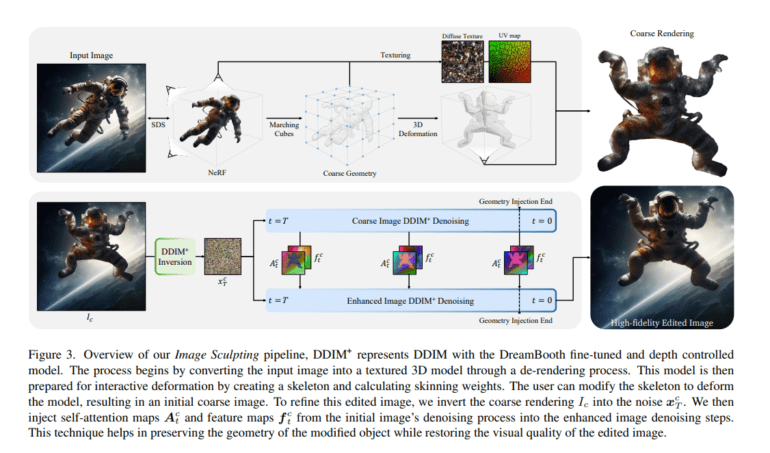TL;DR:
- Image Sculpting, developed by NYU and Intel Researchers, blends 3D tools with 2D image editing.
- It enables precise object geometry control, including pose adjustments, rotation, translation, 3D composition, and more.
- A coarse-to-fine enhancement process seamlessly merges edited objects into original images, yielding high-quality results.
- While promising, Image Sculpting faces challenges with controllability through textual prompts and output resolution.
- Further research is needed to address these limitations and unlock its full potential.
Main AI News:
Traditional 2D image editing methods have long been hampered by their dependence on text-based instructions, resulting in limited precision and control. This confinement within the 2D realm often leads to imprecise object manipulation, stifling the full potential of image editing. The absence of tools for spatial interaction further constrains creative possibilities and fine-tuned adjustments, creating a void in the world of image enhancement.
In recent years, the exploration of generative models like GANs has expanded the horizon of image editing, encompassing style transfer, image-to-image translation, latent manipulation, and text-based modifications. However, text-based editing still struggles to provide accurate control over object shapes and positions. ControlNet is one notable model attempting to bridge this gap by incorporating additional conditional inputs for precise generation. Additionally, the age-old challenge of single-view 3D reconstruction in computer vision has seen substantial progress in algorithmic approaches and data utilization.
Enter Image Sculpting, a groundbreaking method developed by the brilliant minds at New York University. This innovative approach addresses the limitations of traditional 2D image editing by seamlessly integrating 3D geometry and graphics tools. Image Sculpting empowers direct interaction with the 3D aspects of 2D objects, enabling precise adjustments such as pose modifications, rotation, translation, 3D composition, carving, and serial addition.
Leveraging a meticulous coarse-to-fine enhancement process, this framework expertly re-renders edited objects into 2D, seamlessly blending them with the original image to achieve impeccable results. Image Sculpting strikes a harmonious balance between the creative freedom offered by generative models and the precision of graphics pipelines, effectively bridging the controllability gap in image generation and computer graphics.
Despite its remarkable potential, Image Sculpting does have its limitations when it comes to controllability and precision through textual prompts. Requesting intricate object manipulations remains a challenge for current generative models. Moreover, the method’s reliance on the evolving quality of single-view 3D reconstruction may necessitate manual efforts for mesh deformation. Output resolution, while commendable, falls short of industrial rendering standards, making adjustments to background lighting a crucial factor for achieving realism.
Conclusion:
Image Sculpting marks a significant stride in the realm of 2D image editing, but it is undeniably a first step. Further research and development are imperative to overcome these limitations and unlock its full potential, ensuring it becomes an indispensable tool for creative professionals and enthusiasts alike. Stay tuned for the exciting evolution of Image Sculpting in the world of artificial intelligence-driven image editing.

